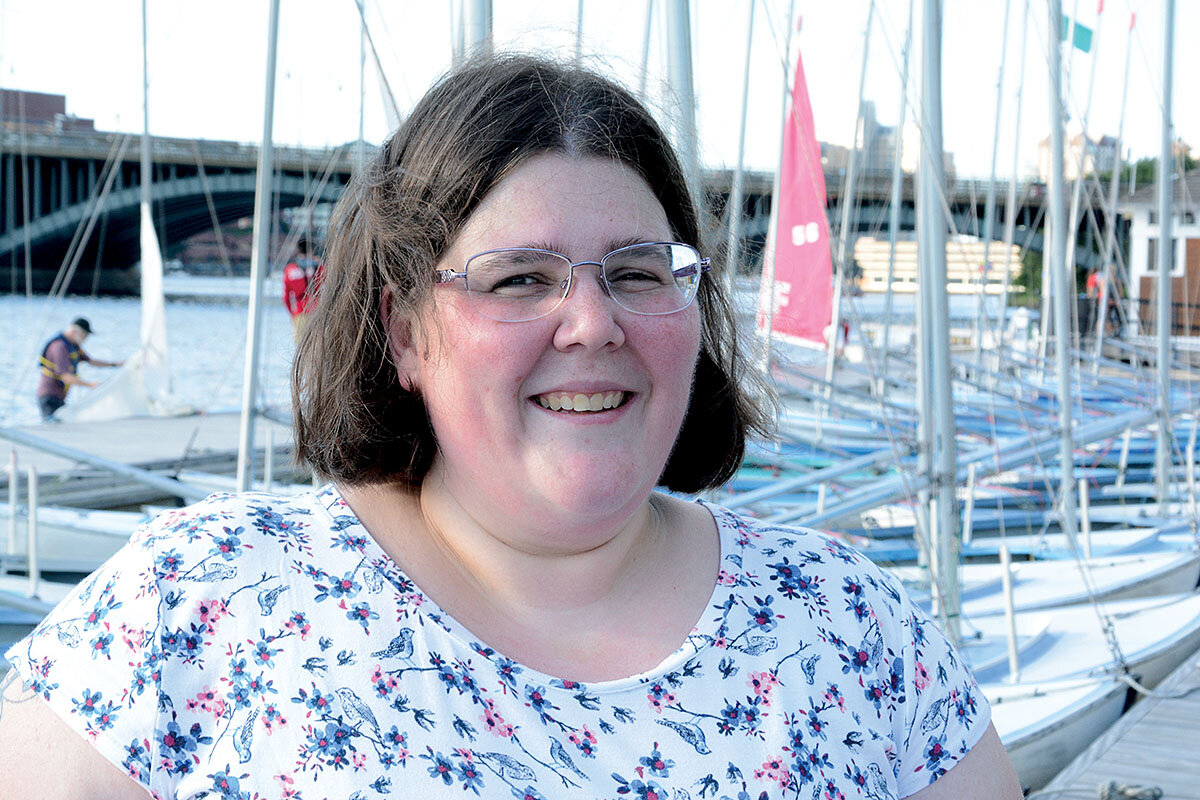‘To feel the wind’: Blind sailors take the helm in Boston Harbor
Loading...
| Boston
Working on a master’s degree, Katherine Kern can’t make as many Saturday sails as she would like anymore. But on the last day of the summer season, she makes sure to arrive at the pier by 10 a.m. She’s set to cruise through Boston Harbor with Jan Lindquist and Peter Fay – her crew for the day.
It’s cloudless and warm with an impulsive wind. Mr. Fay holds the tiller while Ms. Kern and Mr. Lindquist trim the sails. They tack, they jibe; sailing a Rhodes 19, they look like everyone else on the water. They like it that way, too.
“I think of this as a normal thing,” says Ms. Kern. “Other people, they’re like, ‘Wait, what are you doing?’”
Why We Wrote This
Limits were made for breaking – just ask sailors with vision loss. “There is a stereotype that if you’re blind, you can’t do anything,” says Katherine Kern, who has raced in world championships.
Ms. Kern’s only vision is through the corner of her left eye, and Mr. Lindquist was born with a condition that limits his sight. Mr. Fay is their sighted guide, there to spot boats, help board, and dock. He is not their captain. Ms. Kern has sailed for 15 years, and Mr. Lindquist for almost 40. They both learned through the same Saturday morning program that brought them to the water that day: SailBlind.
Founded in 1979, SailBlind was the first structured program in the United States for blind sailors. It’s run by the Carroll Center for the Blind, a vision rehabilitation center in nearby Newton, Massachusetts. SailBlind continues the center’s mission to empower people with vision loss by helping hundreds onto the water.
At first, the program attracted curious participants – mostly from New England – who never thought they could sail. It has since spawned crews that have raced in regattas from Auckland, New Zealand, to Newport, Rhode Island. As the birthplace of the association Blind Sailing International and the training ground for some of the sport’s best, SailBlind put blind sailing on the map – or more appropriately, the chart.
“This restores a lot of pieces for [blind] people,” says Dina Rosenbaum, chief program officer at the Carroll Center. “It gives them independence. It gives them control of an environment. It gives them a social environment. It gives them confidence.”
Wind and waves
SailBlind began with Arthur O’Neill, a former employee of the Carroll Center and a sailor himself, who wanted to help blind people enjoy the outdoors. He started a package of programs – skiing, hiking, canoeing, biking, and sailing – adapted to allow for a lack of sight.
Mr. O’Neill says the Carroll Center partnered with the nonprofit Courageous Sailing, because the latter’s founder had learned how to sail blindfolded from his father, and was the only person receptive to the idea.
“There was a lot of concern by the general public ... on the liability of a blind person sailing and doing those kinds of things,” Mr. O’Neill says. “So we weren’t really met with open arms.”
Many wrongly assume that blindness is the same as closing your eyes. Not only are there different gradations to visual impairment, but blind persons also rely on other senses to compensate for less visual information.
“A lot of sighted people feel that if I close my eyes, I couldn’t walk down a flight of stairs,” Mr. O’Neill says. “Maybe you couldn’t, but you can be taught to do that.”
Every SailBlind crew includes a sighted guide to keep lookout and train new sailors. At first, the guides are teachers – then just passengers.
For most parts of sailing, vision isn’t as crucial as it may seem. To trim the sails and set a course, you first need to sense the wind and its direction. To do this, sailors often rely on telltales – thin strips of yarn attached to the sails. Like their sighted peers, blind sailors parse the wind on their faces. And rather than checking a compass, they can feel the sun’s rising in the east and setting in the west to help with orientation during races. With practice, blind sailors can be in almost complete control.
“It really [feels] great to be on the water,” says Tim Vernon, a participant in his fourth summer with the program. “To feel the wind, to breathe in the salt air, and to be able to hear the ocean and the waves splashing against the side of the boat as you sail through the water – [it’s] really a great feeling.”
“I had to prove myself”
SailBlind coordinator Tom Rowen first joined the program 30 years ago, never having sailed before. Even after being certified as a sighted guide, he was “scared to death” the first time he took a crew out on his own. It took a couple of weeks to get confident.
“Everything ... is verbal commands,” he says. “All it is, is communication.”
When giving directions, Mr. Rowen learned to be clear and direct, both gentle and firm. Not one for “long dissertations,” he prefers to teach by doing.
Ms. Kern learned to sail from Mr. Rowen as a student at the Carroll Center. At first just a weekend activity, sailing is now one of the biggest parts of her life. She goes at least twice a week during warm weather.
“Everybody knows that summer is when I go sailing,” she says. “And I will not make plans with people if I’m going sailing.”
Eventually, weekend cruises weren’t enough for her. She wanted to race.
Competitive sailing, as opposed to recreational, is much different – like NASCAR compared with an evening drive. There’s little time for talking. It’s intense, focused, and precise.
Even in a league for blind sailors, Ms. Kern wasn’t initially welcomed. “It was a struggle and I had to prove myself,” she says. With persistence, she did. Now having raced in giant regattas and world championships, she says she often beats sighted sailors.
“There is a stereotype that if you’re blind, you can’t do anything,” Ms. Kern says. “We can do things just like other people. They just need to be adapted.”
It’s important, Mr. Fay says, for blind people to have the option to do whatever they want to do. Newly trained as a guide this summer, he’s told colleagues with visual impairments about the program. One was excited. The other, afraid of the water, was not at all.
Mr. Lindquist used to be the same way. It took him two years to build confidence. He loves being out on the water now. He says it helps him get away from troubles on land.
“When I first started, I was very afraid of [the water],” he says. “But it wore off, somehow, and then I began to like it.”
During the winter, he thinks of Saturday mornings and summer sails. “You look back on it,” he says, “and then you long for it, you get hungry for it. You can’t wait for summer to come.”







